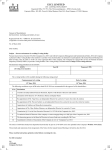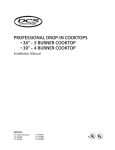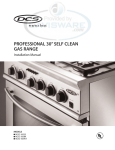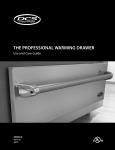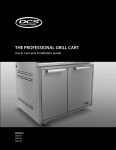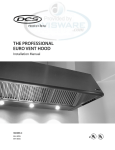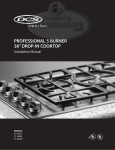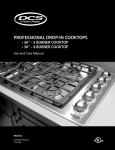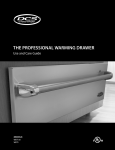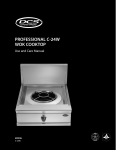Download DCS CT-365 Specifications
Transcript
LP/NATURAL CONVERSION KIT INSTRUCTIONS CT-365 SEALED BURNER COOKTOPS CKL-CT365 Natural to LP CKN-CT365 LP to Natural Before you begin, read these instructions completely and carefully. WARNING This conversion kit must be installed by a qualified service agency in accordance with the manufacturer’s instructions. All applicable codes and requirements of the authority having jurisdiction must be followed. If the information in these instructions is not followed exactly, fire, explosion or production of carbon monoxide may result, causing property damage, personal injury or loss of life. The qualified service agency is responsible for the proper installation of this kit. The installation is not proper and complete until the operation of the converted appliance is checked as specified in the manufacturer’s instructions supplied with the kit. PARTS INCLUDED TOOLS NEEDED Main Burner Orifice (5) 1/8" Flat-blade Screwdriver Phillips Screwdriver Simmer Burner Orifice (5) Adjustable Wrench Ratchet with 1-1/16" Hex Deep Socket Valve Bypass Jet (5) 7mm Nut Driver 25/32" Socket Conversion Sticker (1) 4mm Nut Driver (included) Manometer Valve Stem C-Clip (5) CAUTION: Before proceeding with the conversion, shut-off gas supply to the appliance prior to disconnecting the electrical power. STEP 1 GAS SUPPLY Measure the incoming gas pressure to the regulator. With the installation of this conversion kit, the cooktop should operate on LP gas at 10" of water column pressure and on natural gas at 4" of water column pressure. The pressure regulator must be connected in series with the manifold of the cooktop and must remain in series with the supply line. When checking the regulator, the inlet pressure must be at least 1" greater than the regulator output setting. – If the regulator is set for 10" of water column pressure, the inlet pressure must be at least 11". For proper operation, the maximum inlet pressure to the regulator must be no more than 14" of water column pressure for LP gas and 9" water column pressure for natural gas. 1 Regulator Solid Piping or Flexible Connector Shut-Off Valve Pipe Stub Connection: 1/2" N.P.T. minimum 5/8" dia. metal flex line. IMPORTANT: Disconnect the cooktop and the individual shut-off valve from the gas supply piping system during any pressure testing of that system at test pressures greater than 1/2 psig. Isolate the cooktop from the gas supply piping system by closing the individual manual shut-off valve to the cooktop during any pressure testing of the gas supply piping system at test pressures equal to or less than 1/2 psig. STEP 2 REPLACE ALL BURNER AND VALVE ORIFICES A. To Remove the Cooktop Cooktop removal is required for: Gas piping inspection Wiring service Valve replacement Jet holder service Manifold service Main Jet Simmer Jet Indicator light replacement Valve Bypass Jet Bezel replacement To remove the cooktop: 1. Remove the valve knobs. 2. Remove the burner caps and main burner head (brass). 3. Remove the brass nut using a 1-1/16" socket or adjustable wrench and lift the burner ring from the assembly. 4. Remove the large brass orifice tube from the center of each burner base using a 25/32" socket. 5. Lift each burner base and disconnect the push-on wire terminal from the spark electrode. Place the burner base assemblies in a safe place. Burner Cap Burner Head (Brass) Burner Ring Locking Nut Burner Ring (Aluminum) Locator Pin Electrode Main Orifice Burner Base 7mm Simmer Orifice 4mm 2 6. Raise the cooktop front about 6" and disconnect the 6 pin connector under the cooktop adjacent to the left front valve. 7. Push the spark electrode wire through the holes in cooktop. 8. Pick the cooktop straight up and place in a safe area where it will not be scratched or accidently knocked over. 9. To install the cooktop, reverse the procedure 1 through 8. B. To Access Burner Orifices/Jets: Unscrew the orifice using an appropriately sized conventional socket or nut driver. Use a piece of sticky tape in socket to prevent the loose orifice from falling out. Verify that the orifices in the kit match the chart sizes and replace the orifices. C. To Access Valve Bypass Jets: Remove the c-clips that retain the valve switches and slide the switches off of the valve shafts. Locate the valve bypass jet in the valve body. Using a small 1/8" flat-blade screwdriver, carefully remove the valve bypass jets. Replace each orifice with the marked orifice from the kit. Ensure that the replaced orifice is firmly seated in the valve. Valve Orifice VALVE BYPASS JET VALVE BYPASS JET VALVE SWITCH (REMOVE) ORIFICE SIZES – NATURAL GAS LOCATION MAIN SIMMER (LOW) SIZE MARKING RATE SIZE MARKING REAR 1.51mm 151 11K Btu/hr 0.57mm P FRONT 1.51mm 151 11K Btu/hr 0.57mm CENTER 2.0mm 200 17.5K Btu/hr 0.57mm VALVE ORIFICE (SIMMER) RATE SIZE MARKING RATE 3000 Btu/hr 0.71mm 71 1200 Btu/hr P 3000 Btu/hr 0.71mm 71 1200 Btu/hr P 3000 Btu/hr 0.71mm 71 1200 Btu/hr ORIFICE SIZES – LP GAS LOCATION MAIN SIMMER (LOW) SIZE MARKING RATE SIZE MARKING REAR 0.89mm 89 10K Btu/hr 0.37mm G FRONT 0.89mm 89 10K Btu/hr 0.37mm CENTER 1.10mm 110 15K Btu/hr 0.37mm 3 VALVE ORIFICE (SIMMER) RATE SIZE MARKING RATE 3000 Btu/hr 0.45mm 45 1200 Btu/hr G 3000 Btu/hr 0.45mm 45 1200 Btu/hr G 3000 Btu/hr 0.45mm 45 1200 Btu/hr STEP 3 CONVERT THE PRESSURE REGULATOR WARNING Do not remove the pressure regulator from the cooktop. To convert the regulator from Natural Gas to LP gas or LP to Natural, remove the cap screw using an adjustable wrench and reverse the plastic plunger (make sure the plunger is firmly “swapped” and seated in the cap screw, see illustration to right). Reverse Plastic Plunger LP NAT LP NAT Cap Screw STEP 4 CHECK FOR LEAKS WARNING Check for leaks before attempting to light the burners. Check to be sure all controls are in the OFF position. Turn on the gas supply at the shut-off valve. Use a leak detector at all connections. If a leak is detected, tighten the connection and test again. DO NOT USE A FLAME TO CHECK FOR GAS LEAKS. STEP 5 ASSEMBLE BURNERS, CHECK IGNITION Replace the cooktop, reconnect the wiring and reassemble the burners as shown in Step 2. Check for proper ignition: Connect Electrical. Push in one control knob and turn 90° to “HI” position. The igniter will spark and the burner will light; the igniter will cease sparking when the burner is lit. (Note that all burners will spark.) 4 The first test may require some time while air is flushed out of the gas line. Turn knob to “OFF”. Repeat the procedure for each burner. STEP 6 CHECK FLAME QUALITY Check for proper burner flame characteristics (see illustrations). Burner flames should be blue and stable. Some yellow tipping may be normal on LP Gas. The flame should not have excessive noise or lifting of the flame from the burner. Due to differences in gas characteristics and burner usage (i.e. gas pressure, cleanliness, etc.), burners may perform differently. Burner Operation Two flames are used on all five burners. These dual flame burners have an upper ring of main burner ports which produce the main flame for high heat cooking from the “HI” knob setting to the “LO” knob setting. The bottom simmer flame is used for simmer heat cooking operations such as melting chocolate, holding food at serving temperature and simmering. Both flames are lit when the knob is between “HI” and “LO”. Only the simmer flame is lit when the knob is in the “SIM” position. Burner Adjustment There is no air shutter adjustment, etc. on this burner. The only adjustment available is to clean the burners and clean or replace orifices. Burner Cap High to Low Flame Simmer Flame Simmer Ring Simmer Flame Main Burner Ports STEP 7 COMPLETE AND ADHERE CONVERSION STICKER TO THE COOKTOP BOTTOM SURFACE Complete the required information on the Conversion Sticker and adhere to the bottom of the unit next to Rating Plate Sticker. The Conversion sticker MUST reflect the change in fuel. 5 CONVERSION STICKER SAMPLES A. From Natural Gas to LP B. From LP to Natural Gas THIS CONVERSION RATING LABEL RELATES TO THE FOLLOWING DCS MODELS: CT-365 THIS CONVERSION RATING LABEL RELATES TO THE FOLLOWING DCS MODELS: CT-365 SUPPLY PRESSURE - MINIMUM 11" W.C. MAXIMUM 14" W.C. SUPPLY PRESSURE - MINIMUM 6" W.C. MAXIMUM 9" W.C. MANIFOLD PRESSURE - 10" W.C. MANIFOLD PRESSURE - 4" W.C. INPUT RATINGS - CENTER - 15,000 BTU/HR FRONT - 10,000 BTU/HR REAR - 10,000 BTU/HR INPUT RATINGS - CENTER - 17,500 BTU/HR FRONT - 11,000 BTU/HR REAR - 11,000 BTU/HR CONVERSION KIT PART. CKL-CT365 CONVERSION KIT PART. CKN-CT365 THIS APPLIANCE HAS BEEN CONVERTED ON FROM NATURAL GAS TO LP GAS WITH CONVERSION KIT PART NO. CKL-CT365 THIS APPLIANCE HAS BEEN CONVERTED ON FROM LP GAS TO NATURAL GAS WITH CONVERSION KIT PART NO. CKN-CT365 Name and address of qualified installer or service organization Name and address of qualified installer or service organization WHO ACCEPTS RESPONSIBILTITY FOR THE CORRECTNESS OF THE CONVERSION WHO ACCEPTS RESPONSIBILTITY FOR THE CORRECTNESS OF THE CONVERSION 6 NOTES 7 5800 Skylab Road, Huntington Beach, CA 92647 Tel: (714) 372-7000 Fax: (714) 372-7001 Customer Service: (888) 281-5698 www.dcsappliances.com As product improvement is an ongoing process at DCS, we reserve the right to change specifications or design without notice. P/N 17617 Rev. B 03/03








